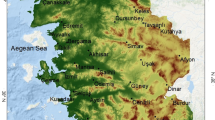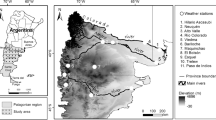Abstract
Climate change has profound environmental and socio-economic implications. To analyze climate change in relation to crops, a wide variety of agro-climatic indices has been proposed by the scientific community. In this study, changes in a set of 12 agro-climatic indices related to temperature were investigated in Central Chile over a 56-year period (1961–2016). The indices were computed based on data referring to daily maximum and minimum temperatures (TX and TN). They were organized in two categories: (1) cold- and (2) heat-related indices. Cold-related indices consisted of first frost day (FFD), last frost day (LFD), frost period (FP), number of frost days (FD), accumulated frost (AF), and number of days when TN is below − 2 °C (FD-2). Heat-related indices included the growing degree day (GDD) index, calculated based on four thresholds which measure the available heat resources for a wide variety of plants with different thermal requirements, and two heat stress indices which quantify the number of days with TX above 25 °C (plant heat stress (PHS)) and above 30 °C (plant high heat stress (PHHS)). Changes in agro-climatic indices were investigated using the Mann–Kendall test and the Sen’s slope estimator. The main results revealed that the FFD occurred later, while LFD occurred earlier, thus determining a shortening of the FP in the northern half of the studied area. Trends in FD, AF, and FD-2 indices generally indicated warmer conditions in terms of TN during the cold period of the year. Agro-climatic indices related to heat showed important changes in Central Chile. Thus, statistically, the majority of trends become significant and indicated enhanced condition for crops in respect of GDD indices. However, from the heat stress perspective, the analyzed indices showed that conditions become worse in most of the studied locations for crops sensible to temperatures higher than 25 and 30 °C.





Similar content being viewed by others
References
Alexander L, Herold N (2016) ClimPACT2 indices and software. The University of South Wales, Sydney https://github.com/ARCCSS-extremes/climpact2. Accessed 7 Feb 2018
Anandhi A, Perumal S, Gowda PH, Knapp M, Hutchinson S, Harrington J, Murray L, Kirkham MB, Rice CW (2013a) Long-term spatial and temporal trends in frost indices in Kansas, USA. Clim Chang 120:169–181. https://doi.org/10.1007/s10584-013-0794-4
Anandhi A, Zion MS, Gowda PH, Pierson DC, Lounsbury D, Frei A (2013b) Past and future changes in frost day indices in Catskill Mountain region of New York. Hydrol Process 27:3094–3104. https://doi.org/10.1002/hyp.9937
Anwar MR, Liu DL, Macadam I, Kelly G (2013) Adapting agriculture to climate change: a review. Theor Appl Climatol 113:225–245. https://doi.org/10.1007/s00704-012-0780-1
Cayton HL, Haddad NM, Gross K, Diamond SE, Ries L (2015) Do growing degree days predict phenology across butterfly species? Ecology 96:1473–1479. https://doi.org/10.1890/15-0131.1.sm
Crimp SJ, Gobbett D, Kokic P, Nidumolu U, Howden M, Nicholls N (2016) Recent seasonal and long-term changes in southern Australian frost occurrence. Clim Chang 139:115–128. https://doi.org/10.1007/s10584-016-1763-5
Croitoru AE, Piticar A (2013) Changes in daily extreme temperatures in the extra-Carpathians regions of Romania. Int J Climatol 33:1987–2001. https://doi.org/10.1002/joc.3567
Croitoru AE, Piticar A, Ciupertea AF, Roşca CF (2016) Changes in heat waves indices in Romania over the period 1961–2015. Glob Planet Chang 146:109–121. https://doi.org/10.1016/j.gloplacha.2016.08.016
Donat MG, Alexander LV, Yang H, Durre I, Vose R, Dunn RJH, Willett KM, Aguilar E, Brunet M, Caesar J, Hewitson B, Jack C, Klein Tank AMG, Kruger AC, Marengo J, Peterson TC, Renom M, Oria Rojas C, Rusticucci M, Salinger J, Elrayah AS, Sekele SS, Srivastava AK, Trewin B, Villarroel C, Vincent LA, Zhai P, Zhang X, Kitching S (2013) Updated analyses of temperature and precipitation extreme indices since the beginning of the twentieth century: the HadEX2 dataset. J Geophys Res Atmos 118:2098–2118. https://doi.org/10.1002/jgrd.50150
Fernández-Long ME, Müller GV, Beltrán-Przekurat A, Scarpati OE (2013) Long-term and recent changes in temperature-based agroclimatic indices in Argentina. Int J Climatol 33:1673–1686. https://doi.org/10.1002/joc.3541
Graczyk D, Kundzewicz ZW (2016) Changes of temperature-related agroclimatic indices in Poland. Theor Appl Climatol 124:401–410. https://doi.org/10.1007/s00704-015-1429-7
Grigorieva EA, Matzarakis A, de Freitas CR (2010) Analysis of growing degree-days as a climate impact indicator in a region with extreme annual air temperature amplitude. Clim Res 42:143–154. https://doi.org/10.3354/cr00888
Harding AE, Rivington M, Mineter MJ, Tett SFB (2015) Agro-meteorological indices and climate model uncertainty over the UK. Clim Chang 128:113–126. https://doi.org/10.1007/s10584-014-1296-8
Hatfield JL, Prueger JH (2015) Temperature extremes: effect on plant growth and development. Weather Clim Extrem 10:4–10. https://doi.org/10.1016/j.wace.2015.08.001
Kaushal N, Bhandari K, Siddique KHM, Nayyar H (2016) Food crops face rising temperatures: an overview of responses, adaptive mechanisms, and approaches to improve heat tolerance. Cogent Food Agric 2. https://doi.org/10.1080/23311932.2015.1134380
Kendall MG (1975) Rank correlation methods, 4th edn. Charles Griffin, London
Luo Q (2011) Temperature thresholds and crop production: a review. Clim Chang 109:583–598. https://doi.org/10.1007/s10584-011-0028-6
Malinović-Milićević S, Radovanović M (2018) Spring and autumn frosts in the Pannonian Basin in Serbia. Geografie 123(1):21–35
Mann HB (1945) Non-parametric tests against trend. Econometrica 13:245–259
Martinez R, Nieto JJ, Freire A, Van der Besselaar EJM, Klein Tank AMG, Van der Schrier G (2012) Daily dataset for climate extreme analyses in Latin America. http://lacad.ciifen.org/. Accessed 15 May 2017
Matthews KB, Rivington M, Buchan K, Miller D, Bellocchi G (2008) Characterising the agro-meteorological implications of climate change scenarios for land management stakeholders. Clim Res 37:59–75. https://doi.org/10.3354/cr00751
Michaud JP (2010) Aphid biodiversity under environmental. Change:69–89. https://doi.org/10.1007/978-90-481-8601-3
Moeletsi ME, Tongwane M, Tsubo M (2016) The study of frost occurrence in Free State Province of South Africa. Adv Meteorol 2016:1–9. https://doi.org/10.1155/2016/9586150
Piticar A, Croitoru AE, Ciupertea FA, Harpa GV (2018) Recent changes in heat waves and cold waves detected based on excess heat factor and excess cold factor in Romania. Int J Climatol 38:1777–1793. https://doi.org/10.1002/joc.5295
Qian B, Zhang X, Chen K, Feng Y, O’Brien T (2010) Observed long-term trends for agroclimatic conditions in Canada. J Appl Meteorol Climatol 49:604–618. https://doi.org/10.1175/2009JAMC2275.1
Salmi T, Maatta A, Anttila P, Ruoho-Airola T, Amnell T (2002) Detecting trends of annual values of atmospheric pollutants by the Mann–Kendall test and Sen's slope estimates—the Excel template application MAKESENS. Publications on Air Quality 31: Report Code FMIAQ-31. http://www.fmi.fi/kuvat/MAKESENSMANUAL.pdf. Accessed 10 May 2018
Sen PK (1968) Estimates of the regression coefficient based on Kendall’s tau. J Am Stat Assoc 63:1379–1389
Spinoni J, Vogt J, Barbosa P (2015) European degree-day climatologies and trends for the period 1951-2011. Int J Climatol 35:25–36. https://doi.org/10.1002/joc.3959
Strong C, McCabe GJ (2017) Observed variations in U.S. frost timing linked to atmospheric circulation patterns. Nat Commun 8:1–9. https://doi.org/10.1038/ncomms15307
Teixeira EI, Fischer G, Van Velthuizen H, Walter C, Ewert F (2013) Global hot-spots of heat stress on agricultural crops due to climate change. Agric For Meteorol 170:206–215. https://doi.org/10.1016/j.agrformet.2011.09.002
Wahid A, Gelani S, Ashraf M, Foolad MR (2007) Heat tolerance in plants: an overview. Environ Exp Bot 61:199–223. https://doi.org/10.1016/j.envexpbot.2007.05.011
Wardlaw IF (1994) The effect of high temperature on kernel development in wheat: variability related to pre-heading and post-anthesis conditions. Aust J Plant Physiol 21:731–739. https://doi.org/10.1071/PP9940731
Wypych A, Sulikowska A, Ustrnul Z, Czekierda D (2017) Variability of growing degree days in Poland in response to ongoing climate changes in Europe. Int J Biometeorol 61:49–59. https://doi.org/10.1007/s00484-016-1190-3
Yadav SK (2010) Cold stress tolerance mechanisms in plants. A review. Agron Sustain Dev 30:515–527. https://doi.org/10.1051/agro/2009050
Acknowledgements
The author acknowledges the data providers in the Latin American Climate Assessment and Dataset project (Martinez et al. 2012) and the Dirección Meteorológica de Chile. The author is thankful to Dr. Vlad Roman for amendments to the English language. Comments on the original version of this manuscript by the editors and the two anonymous reviewers are also very much appreciated.
Author information
Authors and Affiliations
Corresponding author
Ethics declarations
Conflict of interest
The author declares that there are no conflicts of interest.
Rights and permissions
About this article
Cite this article
Piticar, A. Changes in agro-climatic indices related to temperature in Central Chile. Int J Biometeorol 63, 499–510 (2019). https://doi.org/10.1007/s00484-019-01681-6
Received:
Revised:
Accepted:
Published:
Issue Date:
DOI: https://doi.org/10.1007/s00484-019-01681-6




